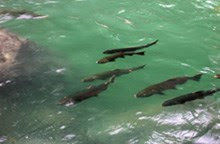Generally, fishes move within restricted
territorial limits and do not go out of their home range. However, a few
species travel long-distance sometime moving from fresh to seawater or vice
versa. This movement of fishes is known as migration in fish.
TYPES OF MIGRATION
Migration
in fishes can be of the following types:-
BASED ON THE PURPOSE OF MIGRATION
On the
basis of migration the fishes can be classified into the following categories
- Alimental
migration
Alimental
migration are those migrations in which the fishes are migrated from one place to
another in search of food and water.
- Gametic Migration
In
Gametic migration, fishes are migrate
from one place to another for the purpose of
reproduction.
- Climatic
migration
When the
fishes migrate from one place to another place for securing more suitable
climatic conditions then migration is known as climatic migration.
- Osmoregulatory Migration
This type
of migrations are facultative and do not occur regularly.
BASED ON THE HABITAT
Diadromous Migration
This is the
true migration in which fish migrate between the sea and freshwater. It can be of
the following three types:-
- Anadromous migration
In
anadromous migration, the marine fishes migrate to freshwater spawning. A
single species of Atlantic Salmon - Salmon salar and five species of Pacific
Salmon – Oncorhynchus exhibit
anadromous migration.
During
winter, both the sexes start migrating from their feeding ground (sea) to
freshwater mountain streams to their breeding ground. They stop feeding,
change to dull reddish-brown from silver. Salmons then make a crude nest by
excavating a shallow saucer-shaped pit in the bottom gravel. After spawning the
adults die. In some Atlantic species of Salmon, a few adults may survive.
EXAMPLE:-
Fishes like Salmon, shad , sea lamprey and Hilsa, sturgeon and some trouts,
Acipenser and Alosa all exhibit anadromous migration.
- Catadromous
migration
It is shown
by those diadromous fishes which feed and become reproductively mature in
freshwater but migrate to the sea for laying eggs or spawning. The famous
example of catadromous migration is
freshwater eel Angulia. It travels several thousand miles starting from its
feeding grounds, the European freshwater rivers to reach its spawning grounds
in the Sargasso Sea off Bermuda.
- Amphidromous
migration
These diadromous fishes migrate from the sea to
freshwaters or from freshwaters to sea.
The purpose of migration is not breeding. This occurs regularly at some
definite stage of life cycle other than a reproductive season. Gobies are said to
exhibit amphidromous migration.
- Patomodromous migration
It includes
migration of fishes from freshwater to freshwaters example carps and trouts
travel long distances in large rivers in search of spawning grounds. After laying eggs these return to
the feeding ground.
- Oceanodromous
migration
It is
migration of marine fishes from one place to another in the ocean. Many marines
fishes like Clupea(herring), Scomber (mackerel), Thunnus (Tuna) travel long
distance in the sea for laying eggs.
BASED ON DIRECTION
- Latitudinal
migration
It is shown
by barracudas (Sphyrna) and Sword fishes (Xiphius gladus). The fish move
towards the north in spring and south in autumn.
- Vertical
migration
It is shown
by deep water fishes, which move up and down daily.
Significance of migration in fishes
As
indicated by Nikolsky relocation is an adjustment towards plenitude. The spawning and nursery grounds may not have
enough food to support both the larvae and adult members of a large population
. Hence there is a separation of spawning, nursery and feeding grounds achieved by migration.
A return to
the parent spawning ground is another explanation for migration. IT is may be of some advantage to a species
to those under which they themselves survived when young. It ensures a better
egg and larval survival.
FACTORS INFLUENCING MIGRATION
Migration in fishes is influenced by various physical, chemical, environmental and
biological factors:
- Physical Factors
These
include depth of water, pressure, temperature, light intensity, photoperiod,
current, turbidity and the nature of the bottom, etc.
- Chemical Factors
These
include salinity, ph, smell and taste of water.
- Biological
Factors
These
include food, oxygen, blood pressure, sexual maturity, biological clock,
physiological clock, endocrine gland and
memory etc.
Presence or
Absence of predators and competitors also influence migration or movement from
one place to other.











No comments
Please do not enter any spam link in the comment box